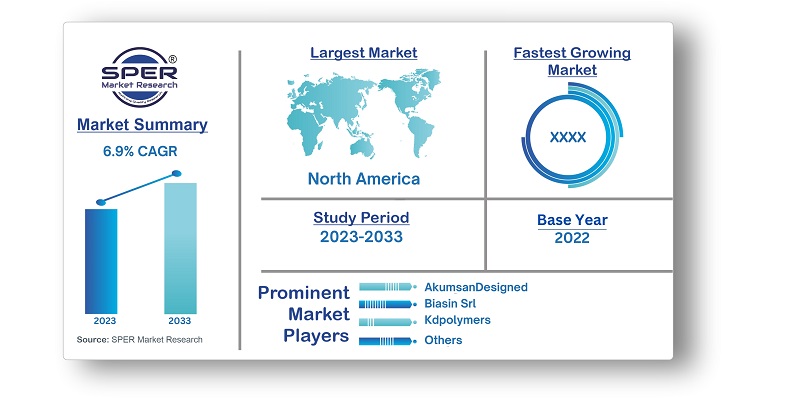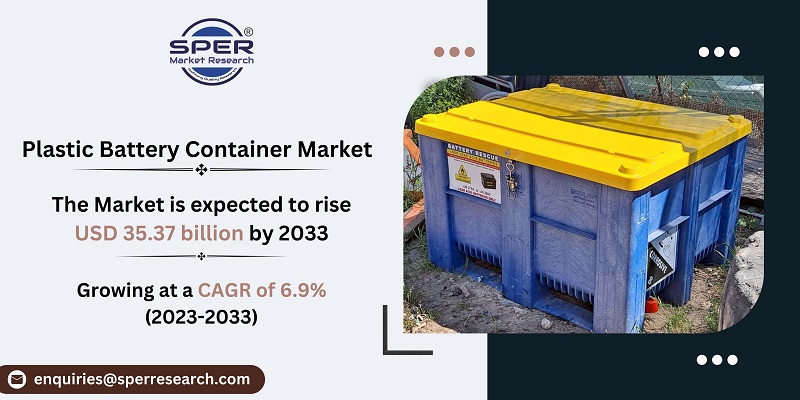
Plastic Battery Container Market Growth, Size, Trends, Revenue, Challenges and Future Competition
Plastic Battery Container Market Size- By Battery, By Resin, By End User- Regional Outlook, Competitive Strategies and Segment Forecast to 2033
| Published: Jul-2023 | Report ID: CHEM2380 | Pages: 1 - 247 | Formats*: |
| Category : Chemical & Materials | |||
- The increasing global adoption of electric vehicles is expected to boost the demand for plastic battery container in the foreseeable future.
- The industry has been significantly affected by the Covid-19 pandemic and the Russia-Ukraine war, leading to widespread disruptions in global supply chains.
- May 2022: LG Chem introduced an advanced plastic material to prevent battery thermal runaway.


| Report Metric | Details |
| Market size available for years | 2019-2033 |
| Base year considered | 2022 |
| Forecast period | 2023-2033 |
| Segments covered | By Battery, By Resin, By End User |
| Regions covered | Asia-Pacific, Middle East and Africa, Europe, North America, Latin America |
| Companies Covered | AkumsanDesigned, Biasin Srl, Kdpolymers, LyondellBasell Industries Holdings B.V., Sanatan, SGL Carbon,TIRTH POLYMERS PVT. LTD., VIKING PLASTICS, Xiamen Tmax Battery Equipments Limited, Others |
- Automotive Industry
- Battery Manufacturers
- Electronics Manufacturers
- Energy Storage Solutions
- Military and Defense
- Recycling and Waste Management
- Renewable Energy Sector
- Retail and Consumers
- Others
| By Battery: |
|
| By Resin: |
|
| By End User: |
|
- Global Plastic Battery Container Market Size (FY’2023-FY’2033)
- Overview of Global Plastic Battery Container Market
- Segmentation of Global Plastic Battery Container Market By Battery (Lead Acid, Lithium Ion, Others)
- Segmentation of Global Plastic Battery Container Market By Resin (Acrylonitrile Butadiene Styrene, Polypropylene, Others)
- Segmentation of Global Plastic Battery Container Market By End User (Automotive, Consumer Electronics, Industrial)
- Statistical Snap of Global Plastic Battery Container Market
- Expansion Analysis of Global Plastic Battery Container Market
- Problems and Obstacles in Global Plastic Battery Container Market
- Competitive Landscape in the Global Plastic Battery Container Market
- Impact of COVID-19 and Demonetization on Global Plastic Battery Container Market
- Details on Current Investment in Global Plastic Battery Container Market
- Competitive Analysis of Global Plastic Battery Container Market
- Prominent Players in the Global Plastic Battery Container Market
- SWOT Analysis of Global Plastic Battery Container Market
- Global Plastic Battery Container Market Future Outlook and Projections (FY’2023-FY’2033)
- Recommendations from Analyst
1.1. Scope of the report1.2. Market segment analysis
2.1. Research data source
2.1.1. Secondary Data2.1.2. Primary Data2.1.3. SPER’s internal database2.1.4. Premium insight from KOL’s
2.2. Market size estimation
2.2.1. Top-down and Bottom-up approach
2.3. Data triangulation
4.1. Driver, Restraint, Opportunity and Challenges analysis
4.1.1. Drivers4.1.2. Restraints4.1.3. Opportunities4.1.4. Challenges
4.2. COVID-19 Impacts of the Global Plastic Battery Container Market
5.1. SWOT Analysis
5.1.1. Strengths5.1.2. Weaknesses5.1.3. Opportunities5.1.4. Threats
5.2. PESTEL Analysis
5.2.1. Political Landscape5.2.2. Economic Landscape5.2.3. Social Landscape5.2.4. Technological Landscape5.2.5. Environmental Landscape5.2.6. Legal Landscape
5.3. PORTER’s Five Forces
5.3.1. Bargaining power of suppliers5.3.2. Bargaining power of buyers5.3.3. Threat of Substitute5.3.4. Threat of new entrant5.3.5. Competitive rivalry
5.4. Heat Map Analysis
6.1. Global Plastic Battery Container Market Manufacturing Base Distribution, Sales Area, Product Type6.2. Mergers & Acquisitions, Partnerships, Product Launch, and Collaboration in Global Plastic Battery Container Market
7.1. Global Plastic Battery Container Market Value Share and Forecast, By Battery, 2023-20337.2. Lead Acid7.3. Lithium Ion7.4. Others
8.1. Global Plastic Battery Container Market Value Share and Forecast, By Resin, 2023-20338.2. Acrylonitrile Butadiene Styrene (ABS)8.3. Polypropylene (PE)8.4. Others
9.1. Global Plastic Battery Container Market Value Share and Forecast, By End User, 2023-20339.2. Automotive9.3. Consumer Electronics9.4. Industrial
10.1. Global Plastic Battery Container Market Size and Market Share
11.1. Global Plastic Battery Container Market Size and Market Share By Battery (2019-2026)11.2. Global Plastic Battery Container Market Size and Market Share By Battery (2027-2033)
12.1. Global Plastic Battery Container Market Size and Market Share By Resin (2019-2026)12.2. Global Plastic Battery Container Market Size and Market Share By Resin (2027-2033)
13.1. Global Plastic Battery Container Market Size and Market Share By End User (2019-2026)13.2. Global Plastic Battery Container Market Size and Market Share By End User (2027-2033)
14.1. Global Plastic Battery Container Market Size and Market Share By Region (2019-2026)14.2. Global Plastic Battery Container Market Size and Market Share By Region (2027-2033)14.3. Asia-Pacific
14.3.1. Australia14.3.2. China14.3.3. India14.3.4. Japan14.3.5. South Korea14.3.6. Rest of Asia-Pacific
14.4. Europe
14.4.1. France14.4.2. Germany14.4.3. Italy14.4.4. Spain14.4.5. United Kingdom14.4.6. Rest of Europe
14.5. Middle East and Africa
14.5.1. Kingdom of Saudi Arabia14.5.2. United Arab Emirates14.5.3. Rest of Middle East & Africa
14.6. North America
14.6.1. Canada14.6.2. Mexico14.6.3. United States
14.7. Latin America
14.7.1. Argentina14.7.2. Brazil14.7.3. Rest of Latin America
15.1. AkumsanDesigned
15.1.1. Company details15.1.2. Financial outlook15.1.3. Product summary15.1.4. Recent developments
15.2. Biasin Srl
15.2.1. Company details15.2.2. Financial outlook15.2.3. Product summary15.2.4. Recent developments
15.3. Kdpolymers
15.3.1. Company details15.3.2. Financial outlook15.3.3. Product summary15.3.4. Recent developments
15.4. LyondellBasell Industries Holdings B.V..
15.4.1. Company details15.4.2. Financial outlook15.4.3. Product summary15.4.4. Recent developments
15.5. Sanatan
15.5.1. Company details15.5.2. Financial outlook15.5.3. Product summary15.5.4. Recent developments
15.6. SGL Carbon
15.6.1. Company details15.6.2. Financial outlook15.6.3. Product summary15.6.4. Recent developments
15.7. TIRTH POLYMERS PVT. LTD.
15.7.1. Company details15.7.2. Financial outlook15.7.3. Product summary15.7.4. Recent developments
15.8. VIKING PLASTICS
15.8.1. Company details15.8.2. Financial outlook15.8.3. Product summary15.8.4. Recent developments
15.9. Xiamen Tmax Battery Equipments Limited
15.9.1. Company details15.9.2. Financial outlook15.9.3. Product summary15.9.4. Recent developments
15.10. Others
SPER Market Research’s methodology uses great emphasis on primary research to ensure that the market intelligence insights are up to date, reliable and accurate. Primary interviews are done with players involved in each phase of a supply chain to analyze the market forecasting. The secondary research method is used to help you fully understand how the future markets and the spending patterns look likes.
The report is based on in-depth qualitative and quantitative analysis of the Product Market. The quantitative analysis involves the application of various projection and sampling techniques. The qualitative analysis involves primary interviews, surveys, and vendor briefings. The data gathered as a result of these processes are validated through experts opinion. Our research methodology entails an ideal mixture of primary and secondary initiatives.



Frequently Asked Questions About This Report
PLACE AN ORDER
Year End Discount
Sample Report
Pre-Purchase Inquiry
NEED CUSTOMIZATION?
Request CustomizationCALL OR EMAIL US
100% Secure Payment






Related Reports
Our Global Clients
Our data-driven insights have influenced the strategy of 200+ reputed companies across the globe.




















